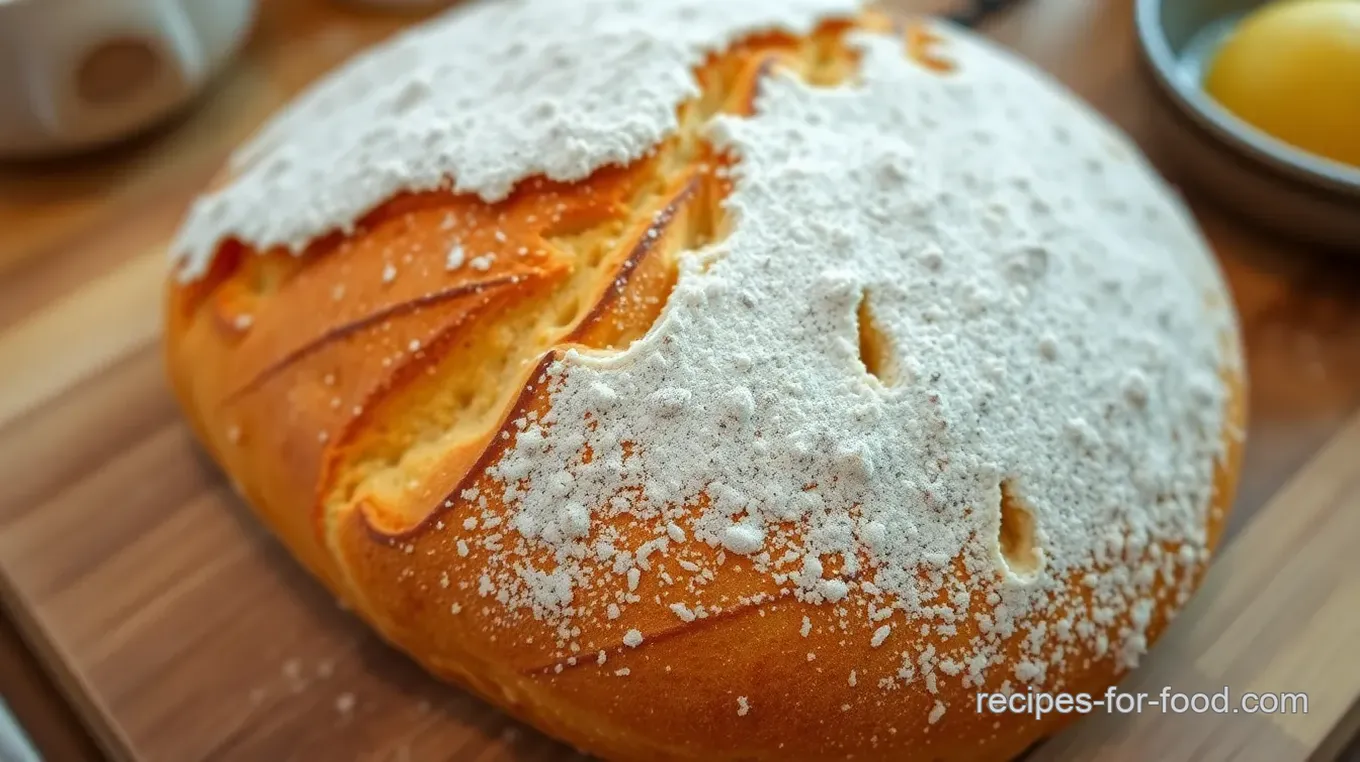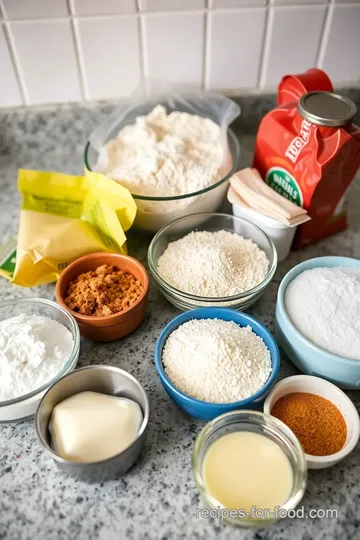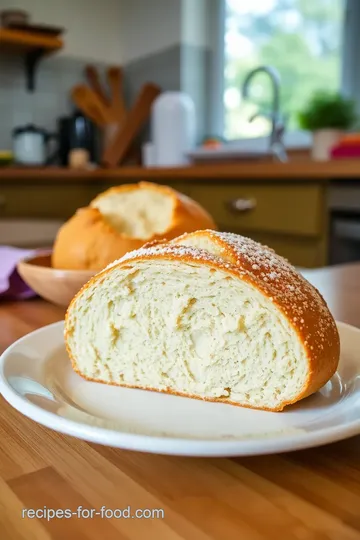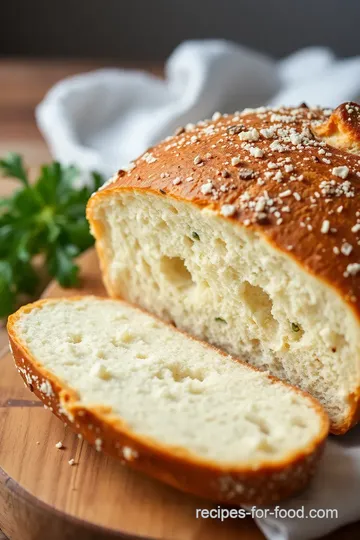Traditional Swedish Limpa Bread
Make delicious Traditional Swedish Limpa Bread in just 1 hour! This easy recipe uses rye flour and spices for a tasty twist perfect for any meal.

- about traditional swedish limpa bread
- master the art of traditional swedish limpa bread
- what makes this recipe special : unique flavor combinations & techniques
- health & nutrition highlights : balanced benefits
- recipe at a glance : quick overview
- master ingredient list
- kitchen equipment essentials
- foolproof cooking steps
- game - changing tips
- perfect presentation
- storage & make - ahead
- creative variations
- expert faq solutions
- complete nutrition guide
- Recipe Card
about traditional swedish limpa bread
when you think of traditional breads, limpa bread stands out as a delightful gem from sweden, this aromatic rye and all - purpose flour loaf is steeped in history, dating back to the 19th century, originally crafted by swedish farmers, it was made using local ingredients and often flavored with spices like anise and coriander, these flavors not only enhanced the bread's taste but also showcased the rich agricultural heritage of sweden .
what makes limpa bread truly special are its unique selling points, first off, it’s incredibly versatile. you can enjoy it fresh out of the oven or toasted with butter for breakfast, paired with cheese for lunch, or even slathered with jam for a sweet treat later in the day, plus, it's relatively easy to make at home – perfect for both novice bakers and seasoned pros looking to explore something new .
master the art of traditional swedish limpa bread
diving into the world of limpa bread means embracing a rich culinary heritage that spans generations, the fascinating origin story behind this recipe highlights how resourceful people were during hard times; they used what they had on hand to create nourishing meals that brought comfort and joy to their families, today, this rustic loaf continues to capture hearts (and stomachs) around the globe.
culturally speaking, limpa bread holds significance in various swedish traditions from holiday feasts to everyday meals symbolizing warmth and togetherness among loved ones, nowadays, its popularity has exploded beyond sweden’s borders as food enthusiasts everywhere seek authentic recipes that evoke nostalgia while satisfying modern palates .
what makes this recipe special : unique flavor combinations & techniques
one bite of homemade limpa bread reveals its unique flavor combinations sweet hints from brown sugar mingling delightfully with earthy notes from rye flour and fragrant spices like cinnamon and coriander dancing on your tongue. it’s a symphony of flavors that will elevate your meal experience .
now let’s talk about foolproof techniques; this recipe is designed so anyone can achieve success. follow my expert - tested method step - by - step without fear; i promise you’ll end up with a beautiful loaf every time (trust me i’ve had my fair share of baking mishaps.), and if you're short on time ? no worries. i’ve got plenty of time - saving tips tucked away throughout this post just for you.
health & nutrition highlights : balanced benefits
when it comes down to health benefits the good news keeps coming. limpa bread offers key nutritional advantages thanks largely due its wholesome ingredients such as whole grains found within rye flour which provides fiber vital for digestive health while keeping those pesky hunger pangs at bay longer than white - flour alternatives might offer .
dietary considerations are also essential here : those who follow vegetarian diets will find this recipe fits right in without compromising flavors or textures since no meat products are involved whatsoever. wellness advantages include antioxidants present within certain spices used alongside minimal added sugars compared other baked goods making them more approachable when indulging occasionally isn’t too guilt - ridden after all.
as far as balanced nutrition facts go ? a slice delivers around 150 calories packed full nutrients you won’t feel deprived enjoying each bite knowing there’s goodness infused into every crumb.
recipe at a glance : quick overview
let me break down everything you need before diving headfirst into baking bliss. the total preparation time clocks in at roughly one hour fifteen minutes spent actively working alongside forty - five minutes waiting patiently while dough rises beautifully before shaping takes place again (cue anticipation.) .
skill level required ? don’t worry it ranks somewhere between beginner - friendly yet offering enough challenge keep experienced bakers engaged too a universal win - win situation if i ever saw one.
serving size details show that one batch yields approximately twelve generous slices allowing everyone share moments over warm bites straight from oven and trust me they’ll be asking for seconds.
lastly but definitely not least the cost efficiency aspect shines bright here because most ingredients come together without breaking bank accounts either…so get ready bake some love today without worrying finances weighing heavier than delicious aromas wafting through kitchen air instead.
so there you have it a delightful introduction into world traditional swedish limpa bread awaits discovery filled rich stories tantalizing tastes waiting unfold right next door we start mixing bowl today shall we ?

master ingredient list
premium core ingredients
creating the perfect limpa bread starts with choosing the right ingredients, here's what you'll need :
-
3 cups all - purpose flour : look for a high - protein flour to give your bread that nice chew, for best results, check that it's fresh and has no lumps .
-
1 cup rye flour : this is key for authenticity. rye adds flavor and texture, so go for dark or medium rye for richer taste .
-
2 tablespoons brown sugar (or regular sugar) : brown sugar gives a lovely caramel note, make sure it’s not hard; fresh sugar will clump less in your dough .
-
1 teaspoon salt : use fine sea salt if you can it dissolves better in dough than coarse salts .
-
2 teaspoons active dry yeast : ensure it's within its expiration date. fresh yeast means better rising power no one wants dense bread.
-
1 teaspoon ground coriander : a warm spice that brings out subtle flavors in the loaf, check it smells fragrant; old spices lose their kick fast.
-
1 teaspoon ground anise seed (or caraway seeds) : anise gives a sweet licorice flavor, while caraway offers an earthy note, pick whichever suits your taste buds.
-
¼ teaspoon ground cinnamon : just a pinch of this goes a long way in adding warmth can’t go wrong here.
-
½ cup warm water (about 110°f/43°c) : always test with your finger to ensure it's warm but not too hot, or you’ll kill the yeast .
-
¾ cup buttermilk (at room temperature) : if you can’t find buttermilk, mix milk with vinegar as a stand - in.
-
2 tablespoons unsalted butter (melted and cooled slightly) : unsalted allows you to control the seasoning; look for high - quality butter like european - style for extra creaminess .
signature seasoning blend
for our limpa bread recipe, we keep things simple yet flavorful :
-
the blend of spices like coriander and either anise or caraway creates depth, trust me; this combo takes your loaf from ordinary to extraordinary.
-
adding herbs isn’t traditional, but if you're feeling adventurous during summer months when fresh herbs are abundant try experimenting with thyme or dill.
flavor enhancers :
consider sprinkling some sesame seeds on top before baking they add crunch and visual appeal.
aromatic additions :
if possible, use freshly ground spices instead of pre - ground ones; they have more vibrant flavors that'll elevate your baking game.
smart substitutions
sometimes life throws curveballs don’t worry. here are some easy swaps :
alternative options :
you can swap brown sugar out for honey or maple syrup if that’s what you've got on hand .
dietary swaps :
gluten - free ? use gluten - free all - purpose flour blends available at stores but make sure they're designed specifically for baking breads .
emergency replacements :
no buttermilk ? mix regular milk with lemon juice or vinegar it works just as well in recipes without any fuss.
seasonal variations :
in fall, try adding pumpkin puree into the dough it’ll make it moist and give off cozy vibes .
kitchen equipment essentials
alrighty then. let’s talk tools you’ll want these essentials handy when making limpa bread :
must - have tools
a sturdy mixing bowl is non - negotiable a large one helps prevent messes while kneading, also grab measuring cups/spoons you know how i feel about accurate measurements.
recommended appliances
an oven thermometer is key to ensuring perfect bake times since ovens vary dramatically between models, and if you have a kitchen scale lying around ? definitely put it to use here .
helpful gadgets
a bench scraper makes transferring dough easier and let’s be honest : who doesn’t love having fewer dishes ?
home alternatives
no rolling pin ? grab a wine bottle instead it works surprisingly well.
pro ingredient tips
here are my personal secrets learned through trial - and - error over many loaves baked :
selection secrets :
always choose organic flours when possible the flavor difference is worth every penny spent .
quality markers :
when buying butter look out for “cultured” varieties; they’re richer compared to standard options which translates into mouthwatering results.
storage solutions :
store leftover flours in airtight containers away from light & heat sources they'll stay fresher longer this way and nobody likes stale bread ingredients . . .
money - saving tips :
buy spices in bulk whenever possible they're cheaper per ounce than those tiny jars at grocery stores plus fresher too.
there ya have it a complete breakdown of everything you'll need to whip up some scrumptious limpa bread right at home. happy baking your future self will thank you once that delicious aroma fills your kitchen.
foolproof cooking steps
creating a delicious dish can sometimes feel daunting, but with these foolproof cooking steps, you'll be whipping up meals like a pro in no time. let’s dive into the essential preparation steps to set you up for success .
essential preparation steps
mise en place details
mise en place is all about getting organized, before you start cooking, gather all your ingredients and tools, for our limpa bread, that means measuring out 3 cups of all - purpose flour, 1 cup of rye flour, and so on, this makes the process smoother and keeps everything at your fingertips .
prep techniques
for this recipe, it helps to have a few bowls handy, one for mixing dry ingredients like flours and spices and another for wet ingredients such as melted butter and buttermilk, don't forget to activate your yeast by combining warm water (about 110°f) with sugar before diving into mixing.
time management
set aside about an hour for this whole process : 15 minutes prep time and around 45 minutes baking time, it’s crucial to allow enough rise time for the dough, so keep an eye on that clock while you're waiting.
organization tips
keep your workspace clean as you go. after measuring each ingredient or completing each step, put things away or wipe down surfaces if needed, this not only keeps things tidy but also helps prevent mix - ups later on .
professional cooking method
now that we’re prepped let’s get into the nitty - gritty of making limpa bread.
1, activate your yeast : start by combining warm water (½ cup), active dry yeast (2 teaspoons), and sugar (2 tablespoons) in a small bowl, let it sit until frothy about 5 - 10 minutes .
1, mix dry ingredients : in a large bowl, whisk together your flours (all - purpose & rye), salt, coriander, anise seed or caraway seeds, and cinnamon until they’re well combined .
1, combine wet ingredients : in another bowl, mix together the activated yeast mixture with room temperature buttermilk (¾ cup) and slightly cooled melted butter (2 tablespoons) .
1, form the dough : create a well in the dry mix; pour in those wet goodies. use either a wooden spoon or your hands to blend until you see a shaggy dough forming .
1, knead the dough : turn it onto a floured surface; knead for about 8 - 10 minutes until it's smooth and elastic it should bounce back when poked gently .
1, first rise : transfer dough into a greased bowl covered with plastic wrap or damp towel; let it rise in warmth until doubled around one hour is perfect here.
1, shape the loaf & second rise : after punching down the air bubbles from your risen dough (don't worry it feels good.), shape it into an oval loaf then cover again loosely letting it rise another 30 - 45 minutes .
1, bake it up : preheat oven to 375°f while waiting. once ready, bake for approximately 45 - 50 minutes till golden brown that hollow sound when tapped on the bottom ? that’s music to any baker's ears.
expert techniques
to ensure success every step of the way :
professional methods
always check that yeast is fresh before using; dead yeast equals flat bread. and use room temperature ingredients wherever specified they work better together during fermentation .
critical steps
while kneading the texture matters. you want something soft yet resilient not too sticky nor crumbly keep dusting flour lightly if needed without overdoing it .
precision points
when shaping loaves : create tension by folding over itself repeatedly before tucking under that'll give you beautiful height once baked.
quality checks
after baking ? look for that lovely golden crust along with tapping checks mentioned earlier the true signs of success are hard not to smile at.
success strategies
every cook faces hiccups now and then we’ve all been there.
troubleshooting tips
if dough doesn’t rise adequately during any stage ? check temperatures too cold can stall growth; too hot may kill off those little yeasty soldiers working hard inside there.
quality assurance
keep track of ingredient freshness dates especially sugars & spices as stale ones change flavor profiles considerably leading us astray from intended taste adventures…
perfect results guide
timing precision truly counts here set timers accordingly throughout stages because nothing worse than losing track mid - bake…yikes right ?.
finally . . .
make sure once cooled completely you slice nicely without squishing those glorious layers within because who wants flat pieces instead ?
with these foolproof steps guiding every aspect from prep through bake you’ll find yourself confidently creating scrumptious dishes worthy of sharing around table gatherings soon enough. happy cooking friends.

game - changing tips
professional insights
when baking limpa bread, the quality of your ingredients matters, always opt for fresh yeast; it makes a world of difference in how well your dough rises, if you’re unsure about the freshness, just sprinkle some on warm water with sugar and wait for it to bubble – that’s your green light.
expert techniques
kneading might seem like a chore, but it's crucial. knead until the dough feels smooth and elastic, it should bounce back when poked this means gluten development is spot on.
kitchen wisdom
if you're short on time, don’t sweat it. you can let the dough rise in a slightly warm oven (turned off) to speed things up, just remember to keep an eye on it so it doesn’t over - rise .
success guarantees
for guaranteed success, invest in an instant - read thermometer, the internal temperature of your loaf should reach around 190°f (88°c) when done, this little gadget will save you from underbaked or overbaked disasters.
perfect presentation
plating techniques
once baked and cooled, slice your limpa bread evenly using a serrated knife for clean cuts, a rustic wooden board makes a great backdrop .
garnish ideas
a sprinkle of caraway seeds or fresh herbs like dill can add visual appeal while enhancing flavor too. don't forget to serve butter or jam alongside for that extra touch .
serving suggestions
this bread shines at gatherings slice it thin and serve with smoked salmon or cheeses for an elegant appetizer spread .
visual appeal tips
consider stacking slices neatly or fanning them out slightly on the board, add colorful accompaniments like cherry tomatoes or olives around the edges for that wow factor.
storage & make - ahead
storage guidelines
wrap leftover limpa tightly in plastic wrap or foil before storing at room temperature to keep it fresh longer ideally consume within three days .
preservation methods
for longer storage, slice and freeze individual pieces wrapped securely; they’ll last up to three months. just toast straight from frozen whenever you crave some homemade goodness .
reheating instructions
to reheat, pop slices into a toaster oven until warmed through; this retains crispness beautifully without drying them out .
freshness tips
always check moisture levels before wrapping leftovers; if there’s any condensation inside the wrap, replace with dry material it helps prevent mold growth.
creative variations
flavor adaptations
feeling adventurous ? swap out spices based on what tickles your fancy. for example : try adding orange zest instead of anise seed for zesty sweetness .
dietary modifications
need a gluten - free option ? use certified gluten - free all - purpose flour along with almond flour as substitute ingredients it may change texture slightly but still tastes amazing.
seasonal twists
in autumn, toss in pumpkin puree along with cinnamon talk about cozy vibes. in springtime consider folding in chopped nuts or dried fruits like cranberries after kneading .
regional variations
want something unique ? try infusing traditional flavors from different cultures by mixing spices such as cumin (middle eastern twist) or fennel seeds (italian flair) .
expert faq solutions
common concerns
are you worried about dense bread ? ensure proper measurements & rising times help avoid that heavy texture issue while also keeping air pockets intact during shaping stages too.
expert answers
q : can i reduce sugar ? a : yes absolutely you could even experiment reducing by half without sacrificing taste much since rye adds natural sweetness already.
q : what if my dough isn’t rising ? a : double - check yeast freshness again & ensure warmth at proofing stage is adequate enough too; sometimes drafty kitchens play tricks there…
troubleshooting guide
if things go wrong mid - bake like cracking tops next time score gently beforehand using sharp knife which helps control expansion better too ensuring lovely rounded shapes instead
success tips
keep experimenting till perfection occurs because baking always involves little nuances specific only you figure out eventually through practice. .
complete nutrition guide
detailed breakdown
each slice contains roughly 150 calories packed full of fiber thanks mainly due rye contents making great addition hearty breakfast options especially paired alongside protein sources. .
health benefits
rye has fantastic health benefits including aiding digestion while providing sustained energy making this limpa perfect everyday choice nourishing body thoroughly overall
dietary information
contains no nuts/dairy aside butter used here enabling flexibility suitable various eating preferences really easily adaptable across diets available today overall facilitating healthful choices made simple each bite taken served wise…
portion guidance
ideal serving size would be one slice during main meals but feel free indulge those who prefer larger portions enjoying two slices worth definitely satisfies appetites quite nicely indeed. .

Traditional Swedish Limpa Bread Card

⚖️ Ingredients:
- 3 cups all-purpose flour (plus extra for dusting)
- 1 cup rye flour
- 2 tablespoons sugar (brown sugar preferred)
- 1 teaspoon salt
- 2 teaspoons active dry yeast
- 1 teaspoon ground coriander
- 1 teaspoon ground anise seed (or caraway seeds for a different flavor)
- .25 teaspoon ground cinnamon
- .5 cup warm water (about 110°F/43°C)
- .75 cup buttermilk, at room temperature
- 2 tablespoons unsalted butter, melted and cooled slightly
🥄 Instructions:
- Step 1: Activate the Yeast: In a small bowl, combine the warm water with the active dry yeast and sugar. Let it sit for about 5–10 minutes until it becomes frothy.
- Step 2: Mix Dry Ingredients: In a large mixing bowl, whisk together the all-purpose flour, rye flour, salt, coriander, anise seed (or caraway), and cinnamon until well combined.
- Step 3: Combine Wet Ingredients: In another bowl, mix together the activated yeast mixture with buttermilk and melted butter.
- Step 4: Form the Dough: Create a well in the center of the dry ingredients and pour in the wet mixture. Using a wooden spoon or your hands, gradually incorporate the flour into the liquid until a shaggy dough forms.
- Step 5: Knead the Dough: Turn out onto a floured surface and knead for about 8–10 minutes until you have a smooth elastic dough that springs back when poked.
- Step 6: First Rise: Place your dough into a lightly greased bowl and cover with plastic wrap or a damp kitchen towel. Allow it to rise in a warm place for about 1 hour or until doubled in size.
- Step 7: Shape The Loaf: Once risen, punch down your dough to release air bubbles. Shape it into an oval loaf by folding it over itself several times before tucking under to create tension on top.
- Step 8: Second Rise: Place shaped loaf on parchment paper lined baking sheet or into an oiled loaf pan if desired; cover again loosely with plastic wrap or cloth towel and let rise for another30–45 minutes.
- Step 9: Preheat Oven: Preheat your oven to375°F(190°C).
Previous Recipe: Instant Pot Roast Beef: Tender & Flavorful
Next Recipe: Shake Up Liquid Cocaine: Refreshing Delight
